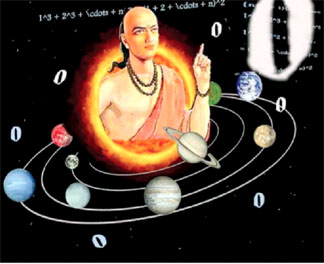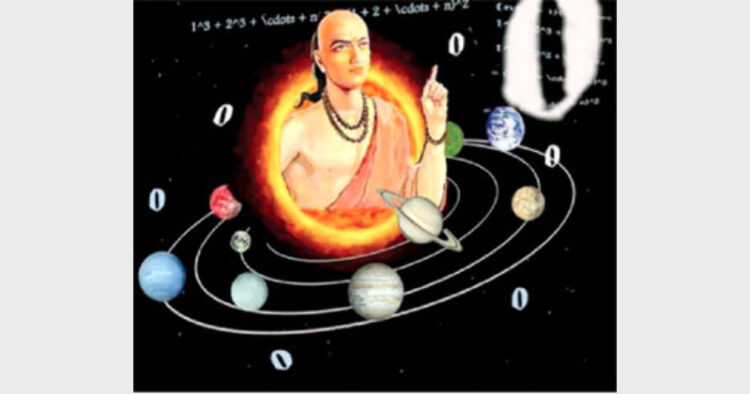 We are never told about achievements of our Hindu past, since the larger academic spaces where textbooks are manufactured have been incarcerated by Marxists
We are never told about achievements of our Hindu past, since the larger academic spaces where textbooks are manufactured have been incarcerated by Marxists
Shaan Kashyap
On April 5, 2016, UNESCO organised an ‘International Conference on Zero’ in Paris, France. On this occasion, the bust of the Bharatiya Mathematician-Astronomer Aryabhata (476-550 CE) was unveiled and donated to UNESCO by the Government of India. The conference was attended by many mathematicians from around the world, including Prof Manjul Bhargava (Princeton University, USA). Prof Bhargava is the only Indian origin mathematician who has won Field’s medal, which is popularly called the ‘Nobel Prize in Mathematics’.
He amazed the learned audience in the conference by demonstrating how the ancient Sanskrit poets, artists and Hindustani classical musicians discovered many mathematical theorems for the first time in history. Manjul Bhargava uses the same Sanskrit poetry, Tabla music, and other similar activities to teach his class in America. He added that during his childhood he had developed a taste for Mathematics because of the influence of these qualities only, which were peculiar to ancient Bharat.
Bharat has always been known for its ancient wisdom and knowledge. The ancient seers and rishi munis were not engaged in knowledge production as we characterise it today in accordance with the modern disciplines. On the contrary, their dharmik and spiritual practices
ushered them into the realm of mysteries and majesty of the creation and nature. In the due process, they discovered laws which used to govern the nature and decoded patterns in the manoeuvre of the universe. The range and magnitude of significant discoveries in all forms of gyan and vigyan is a testimony to the achievements of our culture of knowledge. We need to assert the qualitative difference between science and vigyan now.
However, any manifestations of pride in the ancient glories of the Bharat turn Marxists and proclaimed secularists against it. The reason is simple. Since the ancient period is only Hindu, Vedic, and Sanatani in its origin and character, consenting to their mastery in different walks of life would be a threat to future-oriented ideologies. Marxists have always claimed that their ideology would reach its glory in future, since past represents backwardness and barbarity and future represents progress and civility. Thus, downplaying it and vehemently rejecting the glory of Hindu past is the only logical implication for the Marxists. As far as secularists are concerned, their acceptance of the Hindu past invites a forfeiture of their legitimacy since they have always willingly kept a distance from the religious and cultural domain of the Hindu way of living.
Attack on the tradition
In the series of a similar worked out plan of attack against the Hindu past, Meera Nanda has come out with a book called ‘Science in Saffron: Skeptical Essays on History of Science’ (Three Essay Collective, 2016). In this book, popular Bhartiya mathematical discoveries such as Shunya (zero) and Baudh?yana Sulba S?tra (otherwise known as Pythagoras theorem) have been attributed to other civilisations. This has been done in the garb of what is now called in history as ‘circulation’ and ‘connectedness’.
To put the concept of ‘circulation’ simply, scholars who have been against the concept of nationalism and national culture have started arguing that knowledge and other forms of cultural, economic, and social features were not isolated and peculiar in civilisations. They continuously exchanged ideas and transacted values. Fair enough. But, the process of circulation in an integrated global history cannot brush aside the question of ‘origin’.
We know that the current set of counting numbers is universally used today. This is an idea of circulation. However, can one leave aside the question, ‘Where did these counting numbers originate first?’ Meera Nanda would like us to believe that the origin was certainly not in Bharat, but elsewhere. As for Baudh?yana Sulba S?tra, she claims that the priority of it evaporates ‘the moment one looks beyond India to see what was going on in other major civilisations around the world when Sulba S?tras were composed.’
The four major Sulba S?tras, which are mathematically the most significant, are those composed by Baudhayana, Manava, Apastamba and Katyayana. The texts are dated by comparing their grammar and vocabulary with those of other Vedic texts. The texts have been dated from around 800 BCE to 200 BCE, with the oldest being a sutra attributed to Baudhayana around 800 BCE to 600 BCE. It is striking that Marxist and secular scholars who have huge problems in dating our own ancient texts and epics, don’t have it for others. The range of dates of composition of our texts has varied within centuries for these scholars. On contrary they can precisely date the texts of other civilisations such as Chinese, Egyptian, and Greek, when it comes to refuting the validity of Bhartiya texts. No wonder, Meera Nanda has also done exactly the same!
Nanda has even mocked the claim about the discovery of zero. She takes a jibe stating that ‘India, that is, Bharat, gave zero to the world is the sacred cow of Hindu sciences.’ The implication is that discovery of zero is only a communal misrepresentation of reality. For Nanda, reality is that zero was not invented in Bharat. Rather, the first physical evidence of zero comes from Cambodia. She informs us that the first physical evidence of zero found in Bharat comes from the Chaturbhuja temple of Gwalior, which is known by an inscription dated 876 AD. On the contrary, Manjul Bhargava in the above mentioned ‘International Conference on the Zero’ clearly remarked that the first systematic use of the number system for calculations and scientific work was done by Aryabhata in his work.
Glories of the tradition Manjul Bhargava has also added that apart from adding zero to the number system, another great Bharatiya mathematician Brahmagupta became the first man to give rules to compute with zero. This has led to the development of algebraic expressions in Mathematics. Brahmagupta through his remarkable work called Brahmasphutasiddhanta written in Sanskrit (dated 628 AD) also introduced negative numbers and in the process created a set of complete whole numbers. Thus, the ring of whole number sets created by Brahmagupta revolutionised the way Mathematics and Algebra solved and continues even today. No wonder, famous historian of Science George Sarton called him ‘one of the greatest scientists of his race and the greatest of his time’.
We are never told about achievements of our Hindu past, since the larger academic spaces where textbooks are manufactured have been incarcerated by Marxists and pseudo-secularists. One envies the richness of the Hindu past since they cannot stand the huge advances which were made in our civilisation hundreds of years ago. Others cannot accept it because it threatens their anti-religious stance. It must be underlined that all the
mentioned advances were made by dharmik folks and most of the writing has been done in Sanskrit which is considered Brahmanical, and thus, abhorrent by adversaries of Bharateeyta.
We need to bring back the richness of Hindu past in our textbooks now. Our children must be told that the number system, various sutras (theorems), first textbook of geometry, advances in astronomy, etc. were all invented in our past. Our children need to be taught about greatest of minds such as Aryabhata, Brahmagupta, Bhaskara II, Varahmihira, Mahavira, Hemachandra, Madhava among many others. They need to be taught about modern geniuses such as Srinivas Ramanujan as well, whose formulas are being worked upon in prestigious universities today. A coat wearing Ramanujan after reaching Cambridge University in 1914, still believed that it was the goddess who used to write these amazing equations and formulas on his tongue. Those who have continued to locate Science and Religion in dichotomy must now turn to Vigyan and Dharma to understand mavericks like Ramanujan and many before him.
(The writer is a student of Modern History at Jawaharlal Nehru University, New Delhi)





![A Representative image [ANI Photo]](https://organiser.org/wp-content/uploads/2025/12/representative-image-e1765612818961-120x70.webp)







Comments